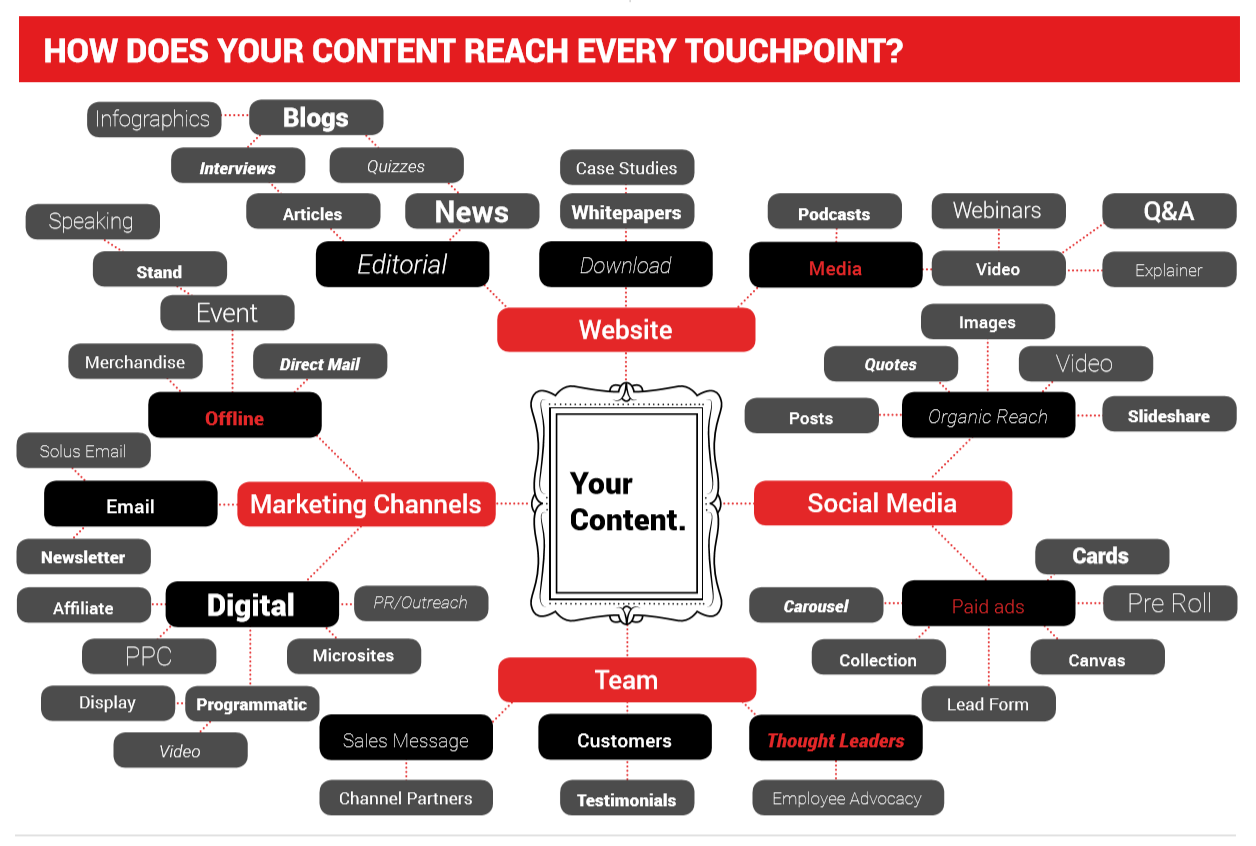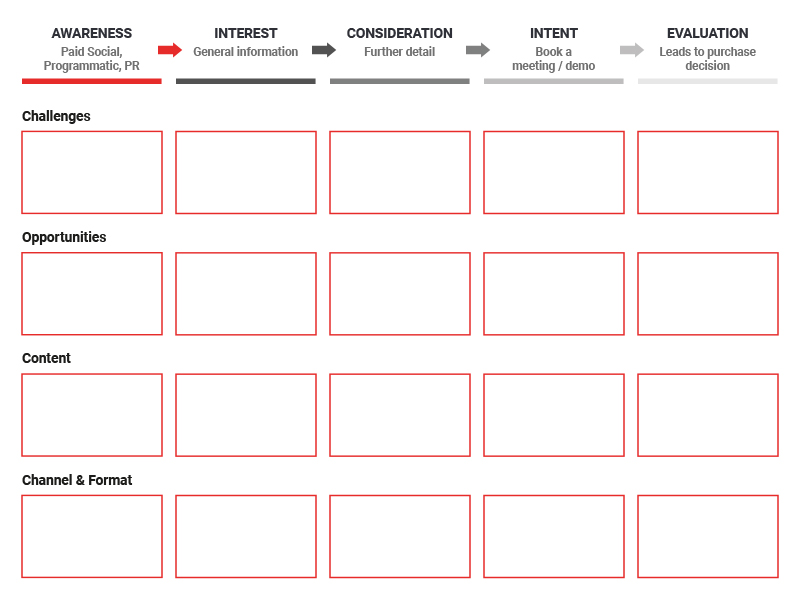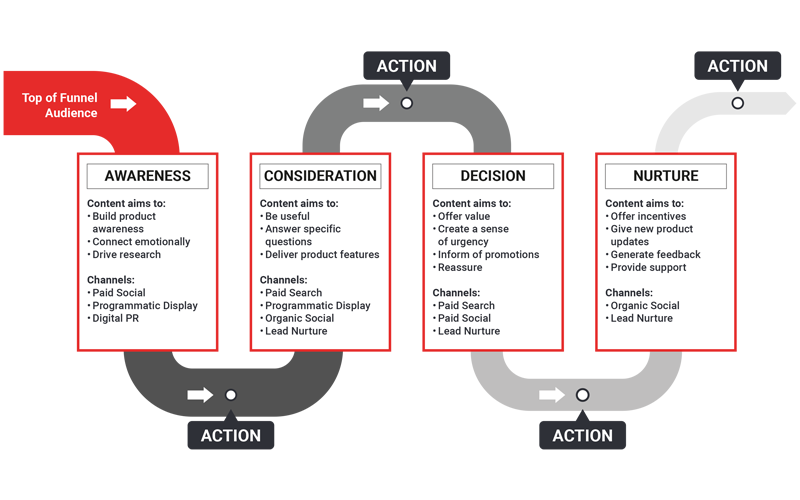The amplification of content is what drives interest to help boost ROI and build brand awareness, but B2B marketers need to focus on getting the messaging right with engaging content in order to effectively amplify it through their multichannel strategy.
Leveraging content and channels to intercept and retain your target audience’s attention is therefore vital. This enables you to build engagement and brand loyalty through delivering consistent messaging across multiple touchpoints along the buyer journey, while ensuring content is relevant to each different member of the decision making unit (DMU).
What does a best-in-class multichannel content strategy look like? How can your carefully crafted content reach every touchpoint? Read on as we take a deep dive into B2B content strategy best practice based on our tried and tested approach…
Reading time: 6 minutes
What is multichannel content?
Just as your B2B marketing strategy involves reaching and communicating with potential customers on different channels, multichannel content creation involves creating various pieces of content and publishing them across different digital platforms. These pieces of content are tailored for specific channels in order to deliver consistent and relevant messaging to your audience.
Why use a multichannel approach for content?
A multichannel content creation approach can be an effective way to reach a wider audience and build a stronger online presence. By using different types of content, such as blogs, articles and video content like podcasts and webinars, you can offer a variety of options to your potential customers and prospects. This approach makes it easier to engage with people on different platforms and devices, as well as providing a more comprehensive coverage of the topics you are interested in. Additionally, it can help to increase your authority, as people are more likely to trust content from multiple sources.
How to improve your multichannel content strategy
1. Create content for the right member of the DMU
More often than not, there’s a growing number of people involved in any decision making process, with nearly 70% of businesses involving 5 or more individuals in every purchase. What’s more, 90% of business professionals agree that there’s usually or always one member of the DMU who will try to influence the decision to match their own.
Differing stakeholder interests makes the whole process more complex too. Take a new technology purchase decision, for instance. Your IT Manager will be concerned primarily with how complex a solution is to implement and how it integrates with their existing tech stack, your Managing Director will be more interested in the up front cost, as well as long-term savings, while Department Heads will be looking to understand how beneficial and easy it will be to adopt into their day to day.
With this in mind, it’s important to target each different member of the DMU with right the type of content that’s specific and relevant to their own individual interests in the particular product or service you are offering. Matched with the most appropriate channel to suit relevant stages of the buyer journey, will allow your content to truly resonate and drive maximum engagement.
2. Produce a personalized content experience
Another essential element to your content strategy is personalization. Why? Well…
- 72% of consumers say they only engage with personalized messaging
- 80% are more likely to purchase from a brand offering a personalized experience
- 90% find personalization appealing.
What’s more, a staggering 99% of marketers agree that customer relationships are advanced by personalization. An accurate micro understanding of target audience segments is therefore crucial to enable precise and effective personalization that achieves a sense of exclusivity. A one-size-fits-all messaging is simply not good enough.
3. Deliver content to reach every touchpoint
You need to uncover the most pressing pain points, interests and challenges of your intended audience to craft appropriate, relevant and timely content that will resonate. As well as select the right content formats to aid discovery, relevancy and accessibility.
Start with crafting your message to align with your target audience. Then develop a content plan that plots out how you are going to make this content useable across your digital ecosystem. Things to think about include…
- How does your content reach the user at every stage of the decision making process?
- Are your chosen formats optimized for channel reach and engagement?
- What conversion journeys sustain long-term value exchanges that keep your audiences moving further down the funnel?
- Are you able to take your core message and dissect it into accessible fragments across your digital ecosystem?
The following diagram is a great place to begin when thinking about how to answer these. It demonstrates how content and channels within your multichannel content strategy should all fit together to form best-in-class content at every touchpoint.

4. Create digestible content
Creating genuinely useful content that your prospects want to read is far more likely to engage your audience. Taking this notion and aligning the right content to your engagement goals, you can achieve a wealth of profitable opportunities:
- Build awareness of your brand expertise and knowledge
- Shape demand by educating your market
- Build trusted relationships with your audience
- Cultivate new business opportunities and brand advocates.
Producing the best types of content to help achieve your goals – from high-quality whitepapers to snackable eBooks and quick infographics – is key. Inbox Insight’s content creation service can help you craft outstanding copy that strikes a chord with your target audiences in the formats that suit them best.
It’s also a good idea to think about all the ways you can repurpose content to support a range of tailored messages to reach users in different formats, including:
Infographics
Quick to digest and pleasing on the eye. A great way to summarize key information and stats from larger pillar pieces, such as whitepapers. Here are some of our own infographics to get you thinking.
Cheat sheets
Invaluable, time-saving templates which aim to help users come to a conclusion simply by filling in the blanks. Cheat sheets provide a meaningful picture while mapping out essential elements, making them a highly useful bottom of funnel tool.
Utility guides
From templates to workbooks to toolkits to action plans, utility guides help B2B marketers identify the needs of their target audience and find ways to align business activities to those needs.
Video content and webinars
An alternative format to text on a page, video content and webinars provide a highly effective interactive element – particularly valuable for visual learners and anyone seeking a quick summary of a heavier topic. They are a great format that can be used at all stages of the funnel.
5. Complete a content audit
How can you reach the right people, at the right time, and with the right message?
Having ample amounts of relevant, engaging and timely content at the ready is crucial to an effective B2B multichannel content strategy. Create a content audit and map it against the customer journey to ensure you have plenty of content to satisfy all channels effectively from start to finish.
Mapping your content to each of the different DMU member interests is also key. You should aim to have a content map for each core group of members within the DMU. This way your content will get in front of the right people when it matters most to them – pushing the right message based on their individual interests and goals.
Here’s a Content Map template to help you start thinking about how and where you can best deliver your content:

You should aim to deliver high-quality content across all relevant channels to create an immersive environment with logical conversion paths that support cumulative knowledge.
The following diagram illustrates not only the role of content as you move prospects down the funnel, but also what channels work best at different stages.

If we were to apply this to an HR purchase decision where a problem has been identified by an HR manager at the Awareness stage, social channels like LinkedIn are the most likely to be relevant to them. During the consideration phase an IT manager – experts in their field – will decide which technology solution is most suitable alongside their current tech stack, often relying on tech review sites and expert tech forums. The CFO will then be interested in the costs involved as well as the projected cost savings.
Evidently, reaching the right member of the DMU at the right stage in the journey is crucial.
6. Understand the who, where, when…
Consider how decision makers will interact with your message in different contexts. Every time someone is able to recall your brand and associate it with a message, it builds buyer recognition. Cross-channel touchpoints help to achieve this and create an even deeper sense of recognition throughout the journey.
Final thoughts
With so many people involved in the B2B DMU – all with different needs and interests in the solution – mapping content along the buyer journey, ensuring that you have the right content formats for channels, and for each member of the DMU will help your multichannel content strategy thrive. If your prospects are immersed in the message that interests and is relevant to them, they are more likely to engage with your brand and keep coming back.







